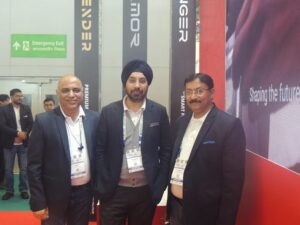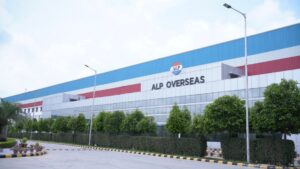Tejbir Singh Anand, Managing Director of ALP Group, highlighted the company’s strategic approach to growth and expansion in an exclusive interview with Bus Coach India Magazine. He emphasized that ALP Group’s well-planned plant locations enable the company to efficiently serve a diverse range of industries while optimizing logistics and supply chain management.
“Our strategic plant locations allow us to cater to various industries efficiently, ensuring seamless operations and cost-effective distribution. By positioning our manufacturing units in key locations, we not only reduce lead times but also enhance supply chain efficiencies, which ultimately benefits our customers,’ said Mr. Anand.
Q: To start, could you introduce ALP to our readers? How was the company founded, and what is its core purpose?
ALP was established in 1983 by my father, Mr. Iqbal Singh. At the time, the company was primarily focused on manufacturing EPDM (Ethylene Propylene Diene Monomer) weather strips for the automotive industry. That was our initial specialization, and over the past forty years, we have undergone significant expansion and diversification. Today, our expertise extends beyond rubber components to include engineering plastics, pharmaceutical plastics, and other associated products. Our commitment to innovation and quality has been a driving force behind our growth in various industrial segments.
Q: In the bus and coach segment specifically, who are some of your key customers?
We have a robust presence in the bus and coach sector, supplying components to all major manufacturers. Our key clients include industry giants such as Tata Motors and Ashok Leyland. Additionally, we supply to several Bus body builders, including SM Kanappa, Veera Vahana, MG, Volvo Eicher, and Azad Coaches. Our customer base is quite extensive, encompassing nearly all bus manufacturers, including SML. This widespread presence allows us to cater to diverse requirements across different vehicle models and specifications.

Q: What are your current investment plans? Are you looking at expanding your production capacity?
Investment is a strategic decision based on market demand. As the market expands and our order volumes increase, we plan accordingly for new investments. Generally, we operate at an optimal capacity of about 70-75%. When we approach that threshold, we proactively invest in additional machinery, infrastructure, and technology to ensure we maintain spare capacity. This approach enables us to sustain seamless production while being prepared for market fluctuations and future growth.
Q: Given that you operate multiple plants, could you give us an overview of your total production capacity and locations?
We have a total of nine manufacturing facilities, each specializing in different product lines. The overall production capacity varies depending on the product category. However, the automotive industry constitutes approximately 55% of our total sales. Our strategic plant locations allow us to cater to various industries efficiently, optimizing logistics and supply chain management.
Q: How do you view the opportunities and strengths within the bus and coach market?
The bus and coach industry is evolving rapidly, driven by increasing demand for premium, comfortable, and air-conditioned buses. This trend presents significant opportunities for us, particularly in the realm of advanced thermal insulation products. Additionally, with the rising adoption of electric buses, weight reduction is becoming a critical factor for manufacturers. We are actively focusing on developing engineering plastics to replace traditional, heavier metal components. These innovations not only contribute to vehicle weight reduction but also enhance overall fuel efficiency and performance, making them an essential aspect of modern vehicle manufacturing.
Q: What are your expansion and growth plans for 2025?
We have ambitious plans for the coming years. Currently, we are in the process of establishing two new manufacturing plants. One facility is being set up in Hyerabad, which will be dedicated to the automotive industry. Meanwhile, the other plant in Nimrana in Rajasthan will focus on the building industry. These expansions align with our broader strategy to strengthen our production capabilities and cater to the growing demand across different industry segments.
Does ALP have a dedicated manufacturing unit specifically for buses and coaches?
We do not operate a separate plant exclusively for the bus and coach segment. Instead, our manufacturing facilities are integrated to serve multiple automotive segments, including passenger cars and commercial vehicles. This integrated approach allows us to optimize production efficiency and resource allocation while catering to diverse market needs.
Q: How do you see the Indian market evolving over the next five years?

The Indian market is poised for significant growth, primarily driven by a large population and increasing consumer affordability. With urbanization on the rise, there is a growing demand for public transportation as well as personal vehicles. These factors contribute to a promising growth trajectory for our business. Additionally, as sustainability and environmental consciousness become more prevalent, we anticipate increased demand for electric and fuel-efficient vehicles, further opening opportunities for our innovative materials and components.
Q: Where is ALP’s research and development (R&D) conducted?
Our primary R&D facility is located in Nimrana in Rajasthan, where we have established a consolidated research and development center. This facility is NABL-certified, ensuring that our innovations adhere to the highest industry standards. Our R&D team focuses on developing cutting-edge solutions in materials engineering, enhancing product performance, and exploring sustainable alternatives to traditional manufacturing processes. This continuous innovation enables us to remain at the forefront of industry advancements.
Q: Is ALP engaged in international markets? If so, could you share some insights into your export strategy?
We have a strong presence in international markets. We export extensively to countries in the U.S., Europe, and Australia. To support aftermarket sales and distribution, we have established our own distribution networks in these regions. This global outreach allows us to serve a diverse clientele while maintaining high standards of quality and reliability in our products.
Q: Do you have a specific target growth rate for exports?
While it is challenging to set a definitive target due to market fluctuations, we are aiming for an annual export growth rate of approximately 20-25%. This growth will be driven by expanding our presence in existing markets and exploring new opportunities across different geographical regions.
Q: With the increasing adoption of electric vehicles (EVs), how is ALP adapting to this shift, particularly in the electric bus segment?
The transition to electric mobility is a defining trend in the automotive industry. Many cities are actively moving towards electric buses to reduce pollution and enhance urban transport efficiency. This shift presents a tremendous opportunity for us. At ALP, we are investing heavily in research and development to create lightweight, high-performance materials suited for electric vehicles. Our focus is on developing engineered plastics and rubber solutions that replace heavier metal components, thereby contributing to weight reduction, improved energy efficiency, and overall vehicle performance.